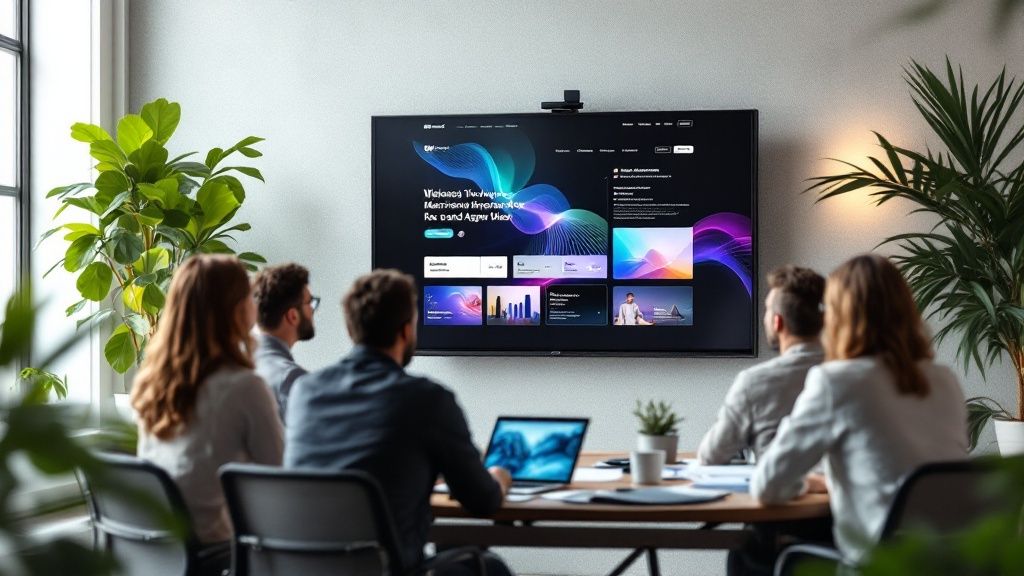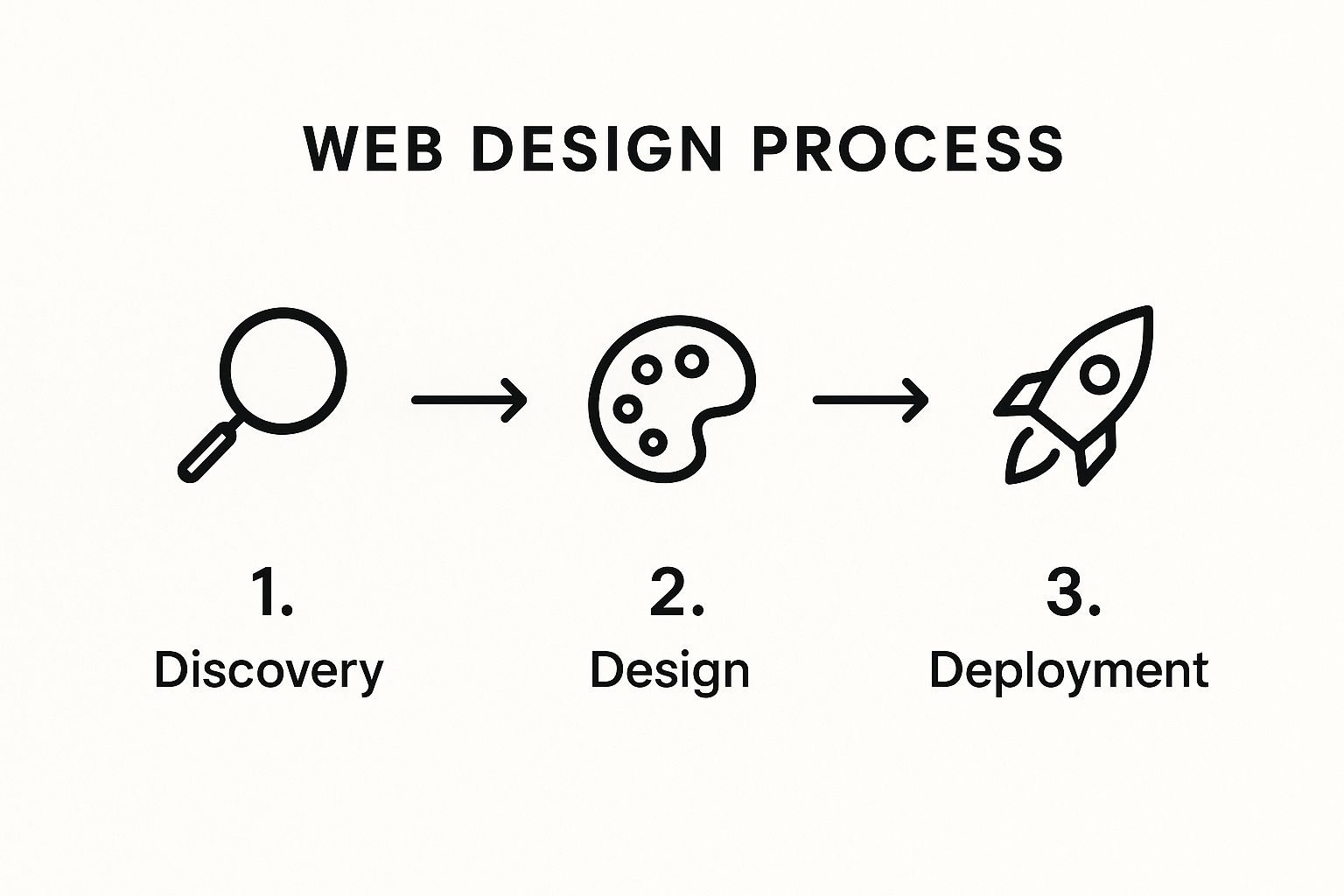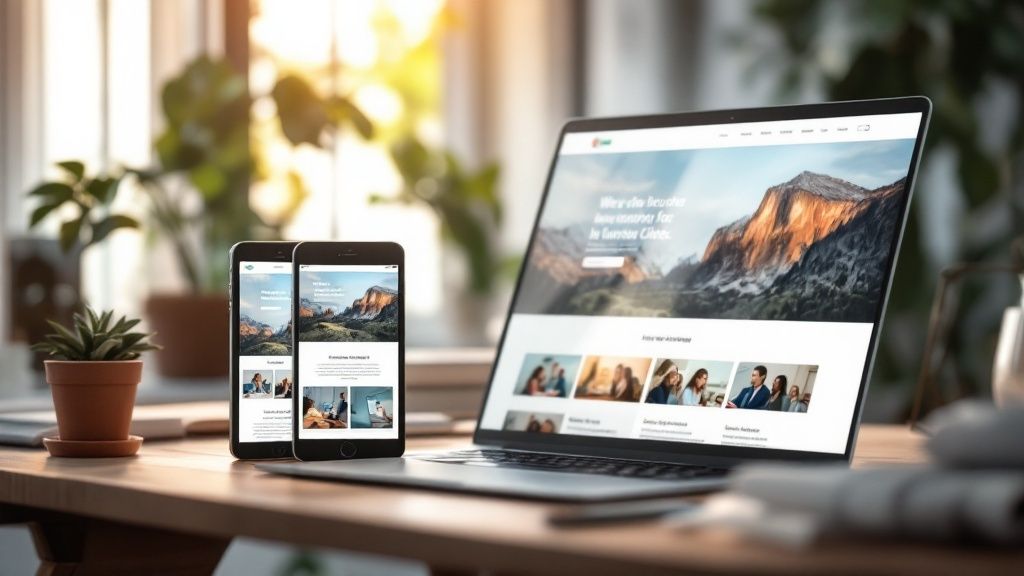When you hear the term "web design company," it’s easy to picture a team of artists making websites look pretty. But that’s only scratching the surface. A true web design company is a strategic partner, a team of architects and engineers for your digital presence.
They don’t just handle aesthetics; they’re responsible for the entire journey of creating a website—from the initial spark of an idea to the launch and ongoing support that keeps it running smoothly.
Understanding What a Web Design Company Really Does

Think of a professional web design company as the architect and builder for your digital storefront. While the colours, fonts, and images are what you see first, their real value is much deeper. They’re responsible for the entire creation process, making sure a website doesn't just look good but actually works as a core business asset.
Their work starts with a deep dive into your business goals. A strategist will get to know your target audience, check out your competitors, and figure out what you need the site to do—whether that's pulling in leads, selling products, or just being an information hub. This discovery phase is absolutely crucial; it lays the foundation for every decision that comes next.
From Blueprint to a Living Website
Once the strategy is clear, the team moves into user experience (UX) and user interface (UI) design. UX designers map out the site’s logical flow, making it a breeze for visitors to find what they need. After that, UI designers step in to craft the visual elements, bringing your brand’s personality to life.
This blueprint then goes to the developers, who turn the design into functional code. Front-end developers build the interactive parts you see and click on, while back-end developers manage the server, database, and all the behind-the-scenes logic. It’s their teamwork that creates a seamless final product.
The best agencies make sure their creations are not just visually appealing but also technically solid. This means focusing on:
- Responsive Design: Making sure the website looks and works perfectly on any device, from a huge desktop monitor to a tiny smartphone. Mastering the concepts behind this is non-negotiable, and you can learn more about responsive web design principles to see why.
- Search Engine Optimisation (SEO): Building the site with best practices baked in from the start, so it has a fighting chance to rank well on search engines like Google.
- Performance and Speed: Optimising everything from images to code for lightning-fast loading times. A slow site is a dead site.
- Security: Putting measures in place to protect the website and its user data from online threats.
A web design company doesn't just hand over a finished product. They build a dynamic platform designed to grow with your business, integrating features that support your goals and adapt to whatever the market throws at you.
The web design sector in India, for example, is incredibly diverse. You’ll find smaller agencies that are wizards with creative WordPress sites, alongside larger firms offering full-blown UX/UI design and digital marketing packages. This variety gives businesses plenty of options to find the perfect technical and creative partner for their needs.
The Core Services That Drive Business Growth

A great web design company does a lot more than just make things look pretty. They offer a whole suite of services that work in harmony to transform a basic website into a serious engine for business growth. When you understand these core pieces, you can have much smarter conversations and pick a partner who will actually deliver results.
These services are the bedrock of any successful digital platform. They’re what ensure your website isn't just nice to look at, but also intuitive, functional, and ready to grow right alongside your business.
To give you a clearer picture, this table breaks down the key services and shows how each one directly benefits your business.
Core Web Design Services and Their Business Impact
| Service | Description | Key Business Impact |
|---|---|---|
| UX/UI Design | Focuses on creating an intuitive user journey (UX) and an appealing visual interface (UI). | Increases user engagement, reduces bounce rates, and guides visitors toward conversion goals. |
| Front-End Development | Builds the interactive, user-facing part of the website using HTML, CSS, and JavaScript. | Ensures a fast, responsive, and consistent experience across all devices, building user trust. |
| Back-End Development | Manages the server, database, and application logic that powers the site from behind the scenes. | Enables complex functionalities like e-commerce and user accounts while ensuring security and performance. |
| CMS Integration | Implements a system like WordPress that allows you to easily manage and update your own content. | Empowers your team to keep the site fresh and relevant, supporting marketing and SEO efforts. |
Each of these elements plays a vital role in creating a digital asset that performs as well as it looks. Let's dig a little deeper into what each one involves.
User Experience and User Interface Design
At the very heart of a website that works is User Experience (UX) and User Interface (UI) design. People often lump them together, but they play two very different—and equally vital—roles.
Think of UX as the architectural blueprint for a house. It decides the layout, the flow from room to room, and how easy it is to navigate the space. It’s all about function and structure.
UI, on the other hand, is the interior design. It’s the colour on the walls, the style of the furniture, and the light fixtures that make the house feel like a home. A top-tier web design company gets that a beautiful interface is completely useless if the experience underneath it is confusing. When great UX and UI work together, they create a seamless journey that gently guides visitors where you want them to go.
Front-End Development
Front-end development is where the static visual designs truly come alive. It's the craft of turning those UI mockups into a live, interactive website that people can actually click, scroll, and engage with. This is literally everything you see and interact with in your browser.
Developers use languages like HTML, CSS, and JavaScript to build out all the interactive elements. The end goal is always to create a responsive, fast-loading, and accessible experience that works perfectly on every device, from a huge desktop monitor right down to a mobile phone. This user-facing side of things is what makes that critical first impression.
Back-End Development
If the front-end is what’s happening on stage, the back-end is everything going on behind the curtain. This is the server-side logic that powers the whole operation. A good analogy is the kitchen of a restaurant—customers never see it, but it’s where all the magic happens to get their meal prepared and delivered.
Back-end developers are the ones managing the database, handling user logins, and making sure the server that hosts the website is running smoothly. Their work ensures data is stored securely and sent efficiently to the front-end. A solid back-end is the invisible foundation that makes complex features like e-commerce checkouts and user accounts possible.
The synergy between front-end and back-end development is non-negotiable. A top web design company ensures these two sides communicate perfectly, creating a fast, secure, and reliable experience for every user.
Beyond just building a site, a professional web design company weaves in strategies to boost user experience and drive growth, including crucial practices like Conversion Rate Optimization (CRO). The Indian web design industry, for example, has seen massive growth by serving global clients. Companies like CISIN have worked with huge brands like Warner Bros and eBay, proving India's role in delivering world-class web solutions. You can learn more about the top web design companies in India on cisin.com.
Content Management System Integration
A Content Management System (CMS) is a platform that puts you in the driver’s seat of your website's content, no coding required. A web design company will integrate a CMS like WordPress, Shopify, or even a custom-built solution to empower your team.
This is a complete game-changer for most businesses. It means you can:
- Publish new blog posts and articles with ease.
- Update product details and pricing in real-time.
- Add new pages or sections as your business grows.
- Manage your library of images and videos.
By handing you the keys to your own content, a CMS ensures your website stays a dynamic and relevant asset. This is a perfect example of how uniting website design and digital marketing leads to sustainable growth, as it lets you adapt your marketing messages on the fly. All these core services work together to build more than just a website; they create a digital platform built for performance.
Navigating the Web Design Project Lifecycle
So you’ve signed the contract with a web design company. That’s the first step in what should be an exciting, collaborative journey. But what happens next? Understanding the typical project lifecycle helps demystify the whole process, letting you know exactly what’s expected of you at each critical stage.
Think of it like building a custom home. There’s a logical sequence, from laying the foundation to that final coat of paint. Skipping a step—or doing them out of order—is a recipe for disaster. A structured process ensures nothing is left to chance. Every professional agency follows a roadmap designed to turn abstract business goals into a tangible, high-performing website.
This methodical approach is what separates the pros from the amateurs, ensuring the final product isn't just a pretty face but is also strategically sound and technically solid.
The infographic below breaks this complex journey down into three core phases, making it easy to see how a project moves from idea to launch.

As you can see, the process flows logically from understanding your needs in Discovery, to creating the visuals in Design, and finally, bringing it all to life during Deployment.
Phase 1: Discovery and Strategy
This is, without a doubt, the most important phase. Before anyone even thinks about colours or fonts, the design company needs to get inside your head and understand your business, inside and out. This usually involves a series of workshops and deep-dive meetings to nail down the essentials:
- Business Objectives: What is this website for? Are you trying to generate leads, sell products directly, or simply establish your brand's authority?
- Target Audience: Who are you talking to? What do they need, what are their pain points, and how do they behave online?
- Competitor Analysis: What are your competitors doing right? More importantly, where are the gaps you can exploit to stand out?
- Technical Requirements: Does the site need any special functions, like e-commerce, custom calculators, or integrations with your existing software?
The result of all this work is a detailed project brief or strategy document. This becomes the North Star for the entire project, making sure everyone is on the same page before a single pixel is pushed.
Phase 2: Design and Prototyping
With a rock-solid strategy in hand, the creative work can finally begin. This phase is about much more than just aesthetics; it's about building an intuitive and engaging user experience from the ground up. It usually happens in a few key steps.
First comes wireframing, which is like creating the architectural blueprint for your website. These are simple, low-fidelity layouts that focus purely on structure and user flow. There are no colours or fancy graphics here—just the bare-bones skeleton of your site.
Next, the User Interface (UI) designer breathes life into that skeleton with visual design. This is where your brand’s colours, typography, and imagery are applied to create the final look and feel. They craft a visual language that connects with your audience on an emotional level.
Finally, these static designs are often transformed into interactive prototypes. These are clickable mockups that let you experience the website’s flow and test its functionality before any code gets written. It's the perfect time to give feedback and request changes.
"A well-defined design process that moves from low-fidelity wireframes to high-fidelity prototypes is crucial. It ensures that foundational user experience issues are solved before the costly development phase even begins."
Phase 3: Development and Launch
Once you’ve signed off on the design, the developers take the wheel. Their job is to turn the visual concept into a fully functional, living website. This is the most technical part of the entire process, where approved designs are translated into clean, efficient code.
The development work is usually split into two streams:
- Front-End Development: This is all about building the part of the website that people see and interact with in their browser.
- Back-End Development: This focuses on the behind-the-scenes stuff—the server, database, and application logic that makes the site work.
After the build is complete, the website goes through rigorous testing and quality assurance (QA). Testers hunt for bugs, check for compatibility across different browsers, and make sure the site works perfectly on every device, from a huge desktop monitor to a small smartphone.
Once everything gets the green light, the site is deployed to a live server for the official launch. But the journey doesn't stop there. A good web design partner will stick around to offer post-launch support and maintenance, keeping your new digital asset secure, fast, and up-to-date.
Why Hiring a Professional Firm Is a Strategic Investment

Tempted to go the DIY route with a website builder? It might look like a clever way to save a bit of cash upfront, but that initial saving often spirals into much bigger costs down the road. Bringing a professional web design company on board isn't just an expense; it's a strategic investment in your business's future.
Think of it like this: you can build a shed from a generic kit, or you can hire an architect and a team of builders to construct a custom home. One gives you a functional but limited structure. The other delivers a secure, scalable, and beautifully crafted asset built to last. The money you put into professional design pays for itself through better performance, a stronger return on investment (ROI), and an online presence that actually works for you.
Expertise That Translates to ROI
The single biggest win from hiring a professional firm is getting instant access to a whole team of specialists. You're not just hiring a designer. You're getting a strategist, a user experience (UX) expert, front-end and back-end developers, and an SEO specialist—all working together.
That collective brainpower ensures every decision, from the underlying code to the user's journey, is laser-focused on your business goals. A professional agency knows how to build a site that doesn't just look incredible but is fine-tuned to drive conversions. They get the psychology of user behaviour and create clear pathways that guide visitors toward taking action, which has a direct impact on your bottom line.
A professional web design company’s primary goal is not just to launch a website, but to deliver a business tool. Their success is measured by your success—more leads, higher sales, and stronger brand engagement.
This is exactly why 73% of companies now invest in design to help their brand stand out from the competition. A polished, professional site builds credibility and trust from the moment someone lands on your page, making it a powerful advantage in a crowded market.
Future-Proofing Your Digital Foundation
A website built by a professional agency is designed to grow with you. They don’t just patch up today's problems; they build for tomorrow's needs. This means creating a scalable foundation that can easily handle new features, a surge in traffic, or changing business goals without needing a complete tear-down and rebuild.
This forward-thinking approach includes:
- Clean and Maintainable Code: Professionals write organised, well-documented code. This makes future updates and troubleshooting far more efficient and less expensive.
- Scalable Architecture: The site’s back-end is built to handle growth, whether that means bolting on an e-commerce store or integrating a new CRM system later on.
- Built-in SEO Best Practices: A skilled web design company weaves SEO into the fabric of the site from day one, ensuring it's technically sound and structured for search engine visibility right from launch.
The broader Indian web development market is a huge part of the global tech economy's expansion. The global web development market, valued at about $70.6 billion in 2024, is on track to hit $141.49 billion by 2033. India is a major player in this growth, with agencies that excel at building scalable, SEO-friendly websites. For more on this, you can explore the top website development companies in India.
Ultimately, investing in a professionally built site makes your digital storefront an asset that grows with you, not a liability that holds you back.
How to Evaluate and Choose the Right Agency
Picking the right web design company is easily the most important call you’ll make for your online presence. You’re not just hiring someone to build a website; you’re looking for a long-term partner who genuinely gets your vision and knows how to turn it into a real business asset. This isn’t a decision to rush. It requires a proper, structured approach that goes way beyond a quick glance at their homepage.
A methodical evaluation process helps you cut through the marketing fluff and find a partner who’s truly on your wavelength. It’s the best way to avoid costly mistakes and make sure the final website actually delivers a return on your investment.
Scrutinise Their Portfolio and Case Studies
The first and most obvious piece of evidence is their past work. An agency's portfolio is its resume, plain and simple. It shows you what they’re capable of, their design style, and the quality of their finished product. But don’t just get distracted by the pretty pictures. You need to dig a little deeper to see if there's any substance behind the style.
Look for a web design company that has a track record in your industry or with businesses of a similar size. It's not a deal-breaker, but it helps. Relevant experience means they already speak your language and understand what your customers expect, which can save a lot of time and back-and-forth.
More importantly, go beyond the portfolio and look for case studies. A great case study should tell a complete story:
- The Challenge: What specific business problem was the client trying to solve?
- The Solution: How did the agency’s design and strategy tackle that exact problem?
- The Results: What was the measurable impact? Look for hard numbers like a jump in conversions, a lower bounce rate, or better search engine rankings.
Case studies are proof that an agency doesn't just build websites—they solve real business problems.
Verify Client Testimonials and Reviews
Testimonials are social proof, giving you a peek into what it’s actually like to work with an agency. The ones on their website are a good start, but you should also hunt for reviews on third-party sites like Clutch, GoodFirms, or even Google. You’re more likely to get honest, unfiltered feedback there.
Pay close attention to what past clients say about the process, not just the final website. You’re looking for comments on their communication, project management, and whether they stick to deadlines and budgets. Consistently positive feedback in these areas is a huge green flag that you’re dealing with a professional and reliable team. If you can, ask the agency for a couple of references you can call directly for an even clearer picture.
Assess Their Communication and Project Management
A stunning design is completely worthless if the process of getting there is a chaotic nightmare. Clear, consistent communication is the foundation of any successful project. Pay attention during your first few conversations. Are they listening more than they’re talking? Are they asking smart questions about your business goals?
A professional web design company will have a clear, well-defined project management process. Ask them to walk you through it.
You should know exactly who your main point of contact will be, how often you’ll get updates, and what tools they use to manage everything. Transparency here isn't just a nice-to-have; it's non-negotiable.
A structured approach like this makes sure everyone is on the same page, deadlines are actually hit, and you don’t get any nasty surprises along the way.
Get Crystal Clear on Pricing and Scope
Pricing can be all over the map between different agencies, so you need to know exactly what you’re paying for. Steer clear of any company that’s vague about costs or won’t give you a detailed proposal. A proper proposal should clearly lay out every single deliverable, the project timeline, and a complete cost breakdown.
Be wary of quotes that seem too good to be true—they usually are. A rock-bottom price often means they’re cutting corners on critical steps like strategy, user testing, or support after the site goes live. Always ask what’s not included. Will there be ongoing fees for maintenance, hosting, or software licences? Getting this sorted out upfront prevents scope creep and unexpected bills down the line.
For those looking for a partner that can handle more than just the website itself, it's worth understanding what a modern website and app development company can bring to the table.
Finally, come to your initial meetings with a list of questions. This puts you in the driver's seat and helps you gather the info you need to make a smart decision. A great partner will welcome your questions and give you thoughtful, honest answers. That first conversation is often the best indicator of the kind of collaborative relationship you can expect.
To help you stay organised, a simple checklist can be a huge help when you're comparing a few different agencies.
Web Design Company Evaluation Checklist
Use this checklist to create a side-by-side comparison of the agencies you're considering. It will help you move beyond a gut feeling and make a decision based on concrete factors that are critical for a successful project.
| Evaluation Criteria | Company A | Company B | Notes |
|---|---|---|---|
| Portfolio Quality & Relevance | Did their work align with our brand aesthetic? Do they have industry experience? | ||
| Case Study Results | Were the results specific and measurable (e.g., +25% conversion)? | ||
| Third-Party Reviews (Clutch, etc.) | What did past clients say about communication and project management? | ||
| Communication Style | Did they listen well? Were their answers clear and direct? | ||
| Project Management Process | Was their process well-defined? Do we know who our contact will be? | ||
| Proposal Clarity & Scope | Was the proposal detailed? Were all costs and deliverables itemised? | ||
| Technical Expertise | Do they have experience with the platforms/technologies we need? | ||
| Cultural Fit & Vibe | Do we feel like we could work well together for several months? | ||
| Overall Cost & Value | Does the price feel justified by the quality and scope offered? |
Remember, the goal isn't to find the cheapest option, but the partner who provides the most value and gives you the highest confidence in a successful outcome.
Common Hiring Mistakes That Sabotage Projects
Choosing the right partner is a massive step, but even with the best intentions, it's easy to fall into a few common traps that can sink a project before it even sets sail. Hiring the wrong web design company costs you more than just money—it can stall your business for months, burn through opportunities, and leave you with a final product that completely misses the mark.
The best defence is knowing what these pitfalls look like. By spotting the red flags early, you can sidestep these costly errors and build a partnership that’s set up for success right from the start.
Focusing Only on the Lowest Price
The single most common and destructive mistake is picking an agency just because they offered the lowest quote. A budget is always a factor, of course, but a rock-bottom price is almost always a huge red flag. It’s often a sign that an agency is cutting corners on the things that actually matter, like strategy, user experience research, or quality testing.
That cheap upfront cost almost always leads to much bigger expenses down the road. You’ll likely run into:
- Costly Rebuilds: A poorly constructed site might need a complete overhaul much sooner than you’d expect.
- Missed Revenue: If the website doesn't convert visitors into customers, it's actively hurting your bottom line.
- Security Vulnerabilities: Skipping robust security measures can open the door to expensive and damaging data breaches.
Try to think of it as an investment, not just a purchase. The agency that delivers the most value and a clear return is a far smarter choice than the one that’s just the cheapest.
Providing an Unclear Project Brief
A web design company can't read your mind. If you hand them a vague, fuzzy project brief, you're practically inviting misunderstandings, scope creep, and a whole lot of disappointment. A request like "we need a modern website" is so broad it's almost meaningless.
Your brief needs to lay out your business goals, target audience, must-have features, and even examples of websites you like (and why you like them). A good agency will help you flesh this out, but that initial vision has to come from you. Without that clarity, the project has no North Star, making it nearly impossible for the final website to hit your expectations.
A detailed brief is the foundation for your entire project. It gets both teams on the same page, shuts down misunderstandings before they start, and makes sure the agency is solving the right problems for your business.
Overlooking Post-Launch Support
The work isn't done the moment the website goes live. Honestly, that’s just the beginning. A classic mistake is forgetting to talk about and lock down a plan for ongoing support and maintenance. Websites need regular updates, security checks, and performance tweaks to stay effective.
Before you sign any contracts, ask potential partners about their post-launch support packages. You need to know exactly what’s included, what their response times are, and how much it costs. Skipping this crucial step can leave you with a great-looking website that quickly becomes outdated, slow, or insecure—completely wiping out your initial investment.
Frequently Asked Questions About Hiring a Web Design Company
Deciding to bring a professional web design company on board is a big move, and it's totally normal to have a few questions before you sign on the dotted line. Getting these common queries sorted out from the start helps you set realistic expectations and guarantees a much smoother project from kickoff to launch. Let's walk through some of the most common questions businesses have.
How Much Should I Budget for a Professional Website?
There's no single price tag for a website. The cost is shaped entirely by how big and complex your project is. A straightforward informational site for a local business will cost a lot less than a massive e-commerce platform with all sorts of custom features. A professional web design company will give you a detailed proposal breaking down all the costs, which can run anywhere from a few thousand to several lakhs of rupees.
Think of it like building a house: a pre-designed plan is cheaper than a custom architectural masterpiece. The key is to focus on the value the website will bring, not just the initial cost. A well-built site is an investment that should generate a positive return.
What Is a Realistic Timeline for a Web Design Project?
Just like cost, project timelines can vary a lot. A standard website for a small business can often be designed and launched in 4-8 weeks. But if you're talking about more complex builds, you could be looking at three to six months, or sometimes even longer.
The schedule really comes down to a few key things:
- Project Scope: How many pages are we talking about? Do you need custom features or integrations?
- Client Feedback: Your speed in providing feedback and content is a huge factor.
- Agency Workflow: Every company has its own internal processes that affect the timeline.
What Information Do I Need to Provide to Get Started?
To get the ball rolling, the web design company you choose will need a solid understanding of your business. You should be ready to hand over your brand guidelines (think logo, colours, and fonts), all the content for the website (text and images), and a clear picture of what you want to achieve. The more you can give them upfront, the better they can turn your vision into a real, successful website.
For a deeper dive into common questions about website design, costs, and finding the right agency, this comprehensive website design FAQ is a great resource.
At KP Infotech, we build high-performance websites and applications designed to deliver measurable results. Let's discuss how we can turn your digital vision into a competitive advantage. https://kpinfo.tech
